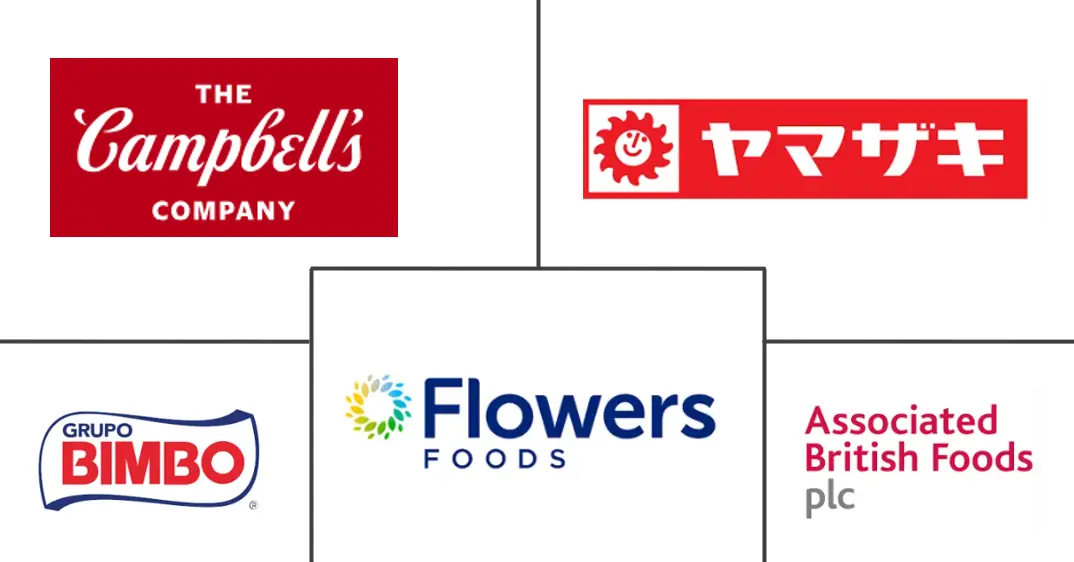Bread Market Size and Share
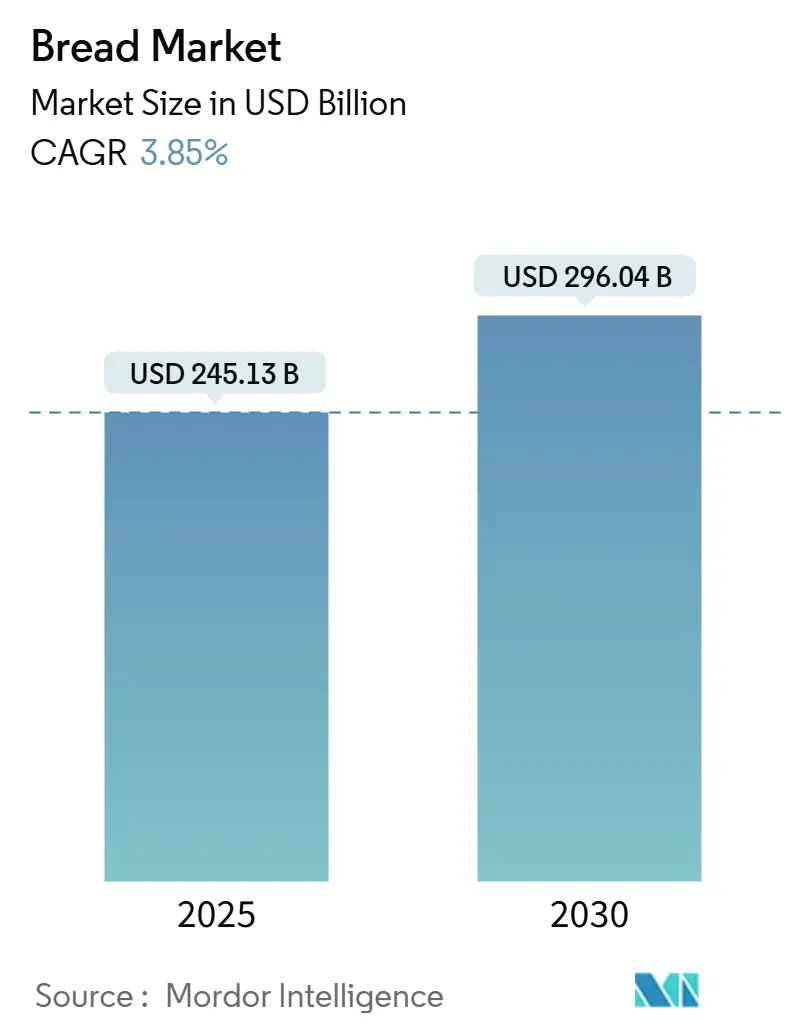
Bread Market Analysis by Mordor Intelligence
The bread market’s current valuation stands at USD 245.13 billion in 2025 and is projected to reach USD 296.04 billion by 2030, translating into a steady 3.85% CAGR. Europe anchors demand with deeply rooted consumption habits, while Asia represents the fastest-growing geography as urban households purchase more packaged toast and single-serve rolls. Premiumisation remains a defining lens: high-protein formulas, gluten-free variants, and organic certification allow bakers to lift average selling prices even when volume gains taper in mature regions. Leading producers are also hedging wheat purchases and raising capital expenditure on cold-chain logistics to balance cost volatility with differentiation. Collectively, these moves show that the bread market is evolving from scale-only competition to a blend of efficiency, nutrition science, and supply-chain agility in the bread market.
Key Report Takeaways
- By product type, leavened bread led with a 57.65% share of the bread market in 2024; unleavened/flat bread is projected to expand at a 4.42% CAGR through 2030 in the bread market.
- By ingredient type, the wheat bread segment held 57.54% of the bread market in 2024, while gluten-free bread is poised for an 8.40% CAGR to 2030 in the bread market.
- By nature, conventional accounted for 85.21% of the market in 2024; organic posted the fastest 9.27% CAGR through 2030.
- By distribution channel, off-trade channels captured 65.34% revenue in 2024; on-trade channel is growing at a faster CAGR of 7.33% through 2030
- By geography, Europe commanded a 29.82% share of the bread market in 2024, and Asia-Pacific is the fastest-growing region at 4.83% CAGR.
Global Bread Market Trends and Insights
Drivers Impact Analysis
| Driver | (~) % Impact on CAGR Forecast | Geographic Relevance | Impact Timeline |
|---|---|---|---|
| Rising Demand for Functional and Fortified Breads Boosts Demand | +0.7% | North America, with spillover to Europe | Medium term (3-4 years) |
| Rapid Urbanization Driving Packaged Bread Adoption | +0.8% | Asia, particularly China, India, and Japan | Long term (≥5 years) |
| Expansion of Artisanal In-store Bakeries | +0.5% | Europe, particularly UK, Germany, and France | Medium term (≈3-4 years) |
| Government Wheat Subsidy Programs Increasing Affordability | +0.4% | Middle East, particularly Saudi Arabia and UAE | Short term (≤2 years) |
| E-commerce Penetration Increasing Direct-to-Consumer Frozen Bread Sales | +0.6% | Global, with highest impact in North America and Europe | Medium term (3-4 years) |
| Technological Advances in Baking Improve Shelf Life and Production Efficiency | +0.5% | Global, with early adoption in developed markets | Medium term (3-4 years) |
| Source: Mordor Intelligence | |||
Rising Demand for Functional and Fortified Breads Boosts Demand
Consumers are increasingly choosing bread products that offer health benefits beyond basic nutrition, which is driving significant changes in product development. This trend has evolved from focusing on protein enrichment to emphasizing fiber fortification. Manufacturers are actively incorporating ingredients like bamboo fiber to create bread with high fiber content, ensuring that the taste and texture remain appealing to consumers. These health-oriented bread products are typically priced 20-30% higher than regular bread, which has led to faster growth in value compared to volume. Major manufacturers, such as Flowers Foods, are addressing this growing demand by introducing products like Nature's Own Keto Soft White Buns and Dave's Killer Bread Amped-Up Protein Bars. As formulation technologies continue to improve and consumers become more health-conscious, this trend is expected to grow further in the medium term, creating more opportunities for innovation in the bread market.
Rapid Urbanization Driving Packaged Bread Adoption
Urbanization in Asia is significantly transforming bread consumption habits. As per a UN-Habitat report, Asia is home to 54% of the world's urban population, translating to over 2.2 billion individuals. Projections indicate that by 2050, Asia's urban populace will swell by another 1.2 billion, marking a 50% increase [1]UN-Habitat, "Asia and the Pacific Region", www.unhabitat.org. People are increasingly moving away from the traditional practice of buying fresh bread daily and are instead opting for packaged bread with a longer shelf life. This shift is particularly prominent in China, India, and Japan, where rapid urban population growth, busier lifestyles, and changing retail environments are driving this change. The packaged bread segment in these countries is expanding at a much faster rate than the overall bread market, creating substantial new demand opportunities for manufacturers in the bread market.
Modern retail formats, such as supermarkets and convenience stores, along with advancements in cold chain infrastructure, are playing a crucial role in this growth. These developments are enabling packaged bread products to reach tier-2 and tier-3 cities, areas that were previously underserved by bread manufacturers. As a result, more consumers in these regions now have access to packaged bread, further fueling its demand. The impact of urbanization on bread consumption is gradual but steady. These trends are expected to persist throughout the forecast period and beyond, indicating a long-term structural shift in the bread market.
Expansion of Artisanal In-store Bakeries
The expansion of artisanal in-store bakeries in Europe is a key trend shaping the bread market. As consumers increasingly prioritize healthier, natural, and additive-free options, artisanal breads have gained significant traction. France, renowned for its baking heritage, exemplifies this trend with the rapid growth of artisanal bakery chains. Ange Boulangerie, a prominent player, has expanded significantly, reaching 252 stores by 2025. Its emphasis on traditional methods, such as slow fermentation for sourdough, and the use of organic ingredients, has resonated strongly with French consumers. Similarly, Marie Blachère, with over 600 locations across France, highlights the appeal of fresh, daily-baked artisanal bread, including pain de campagne and specialty baguettes. These chains are increasingly integrating in-store bakeries into their operations, enhancing the consumer experience by offering freshly baked products on-site.
This trend is not confined to France alone. Across Europe, in-store artisanal bakeries are becoming a staple in supermarkets and hypermarkets, blending convenience with quality. Retailers are leveraging this model to attract health-conscious consumers and differentiate themselves in a competitive market. The medium-term impact of this trend underscores its deep roots in leading markets and its gradual spread to other European nations and diverse retail formats. Europe, which accounts for 29.82% of the global bread market, is at the forefront of this movement. While its influence on the global CAGR remains moderate, the region's focus on artisanal in-store bakeries is setting a benchmark for other markets to follow in the bread market.
Government Wheat Subsidy Programs Increasing Affordability
Countries in the Middle East and North Africa (MENA) region, with Egypt as the world's largest wheat importer, heavily depend on wheat imports to satisfy their bread production needs. Bread holds a pivotal place in the region's diet, serving as a staple food for millions. To ensure bread remains affordable and consumption rises, MENA governments are ramping up wheat subsidies. This approach not only bolsters food security and social stability but also cultivates a safeguarded market landscape, which is critical in a region prone to economic and political volatility.
Egypt boasts one of the globe's most extensive bread subsidy initiatives, dispensing five daily loaves of baladi (wholewheat flatbread) to a staggering 60 million citizens. Such policies foster a consistent pricing framework for Middle Eastern bread producers, setting them apart from their global counterparts by reducing cost uncertainties. This stability allows firms like Almarai to channel their energies into product innovation rather than cost management, enabling them to cater to evolving consumer preferences. These measures not only uplift consumer purchasing power but also promise to drive market expansion in the coming years, particularly as governments continue to prioritize food security in their economic agendas in the bread market.
Restraints Impact Analysis
| Restraint | (~) % Impact on CAGR Forecast | Geographic Relevance | Impact Timeline |
|---|---|---|---|
| Volatility in Global Wheat Prices Compressing Margins | -0.6% | Global, with highest impact on small producers | Short term (≤2 years) |
| Safety Concerns and Product Recalls | -0.4% | Global, with higher impact in developed markets with strict regulations | Medium term (3-4 years) |
| Cold-chain Gaps Limiting Frozen Bread Distribution | -0.3% | Africa and parts of South Asia | Long term (≥5 years) |
| Growing Popularity of Low-Carb Diets Negatively Impacts Bread Consumption | -0.5% | North America and Europe primarily | Long term (≥5 years) |
| Source: Mordor Intelligence | |||
Volatility in Global Wheat Prices Compressing Margins
Global wheat price volatility is squeezing margins across the bread value chain, with smaller producers grappling most due to fluctuating input costs. Wheat production's sensitivity to weather means that droughts, floods, or extreme temperatures can curtail yields, tightening supply and driving up prices. For example, in 2024, the U.S. Department of Agriculture (USDA) highlighted that adverse weather in the European Union slashed wheat production estimates by about 3.7 million metric tons (MMT) to 130.5 MMT, fueling global price surges [2]U.S Department of Agriculture, "Wheat Outlook: September 2024", www.usda.gov.
Additionally, India's move to restrict wheat exports for domestic price stabilization curtailed global supply, amplifying price volatility. This decision hit bread manufacturers in the Middle East, who depended on Indian wheat, resulting in elevated production costs and squeezed margins. Given that wheat constitutes 30-40% of production costs, its price swings have a direct bearing on profitability and curtail investment prospects. The immediate repercussions of these price fluctuations are clear in operating margins, and the persistent supply-demand imbalance indicates this strain will continue throughout the forecast period. Yet, as producers adjust to demand signals, the situation may gradually stabilize in the bread market.
Cold-chain Gaps Limiting Frozen Bread Distribution
Inadequate cold chain infrastructure in emerging markets restricts frozen bread distribution and slows the growth of this segment. Africa and parts of South Asia face the most significant challenges, as inconsistent refrigeration throughout the distribution chain harms product quality and safety. Developing cold chain infrastructure is costly, creating high barriers for manufacturers and distributors to enter these markets. While investments in refrigeration systems are increasing, achieving full infrastructure coverage will take longer than the forecast period, highlighting the long-term nature of this issue. This challenge primarily affects regions that currently contribute less to global bread consumption. However, as consumer preferences in these areas shift toward convenience and products with longer shelf life, the lack of proper cold chain infrastructure will increasingly hinder market opportunities and growth potential in the bread market.
Segment Analysis
By Ingredient Type: Wheat Bread Reigns Supreme, Gluten-free Innovations Surge
In 2024, wheat bread commands a dominant 57.54% share of the market. This significant market share highlights its widespread consumer preference and strong positioning within the global bread market. Wheat bread's popularity can be attributed to its perceived health benefits, including higher fiber content and essential nutrients compared to white bread. Additionally, the growing trend of health-conscious eating and the increasing demand for whole-grain products have further propelled its adoption. Manufacturers are also innovating within this segment by introducing fortified and organic wheat bread variants, catering to diverse consumer preferences. The segment's robust performance underscores its critical role in driving the overall growth of the global bread market.
Despite wheat bread commanding a dominant market share, gluten-free bread is making significant inroads, projected to grow at an 8.40% CAGR from 2025 to 2030. This surge is driven by a combination of medical necessity, such as celiac disease and gluten intolerance, and lifestyle preferences, as more consumers perceive gluten-free products as healthier alternatives. Studies by the University of Nebraska reveal that around 25% of Americans are now embracing gluten-free diets, further contributing to the growing demand for gluten-free bread.
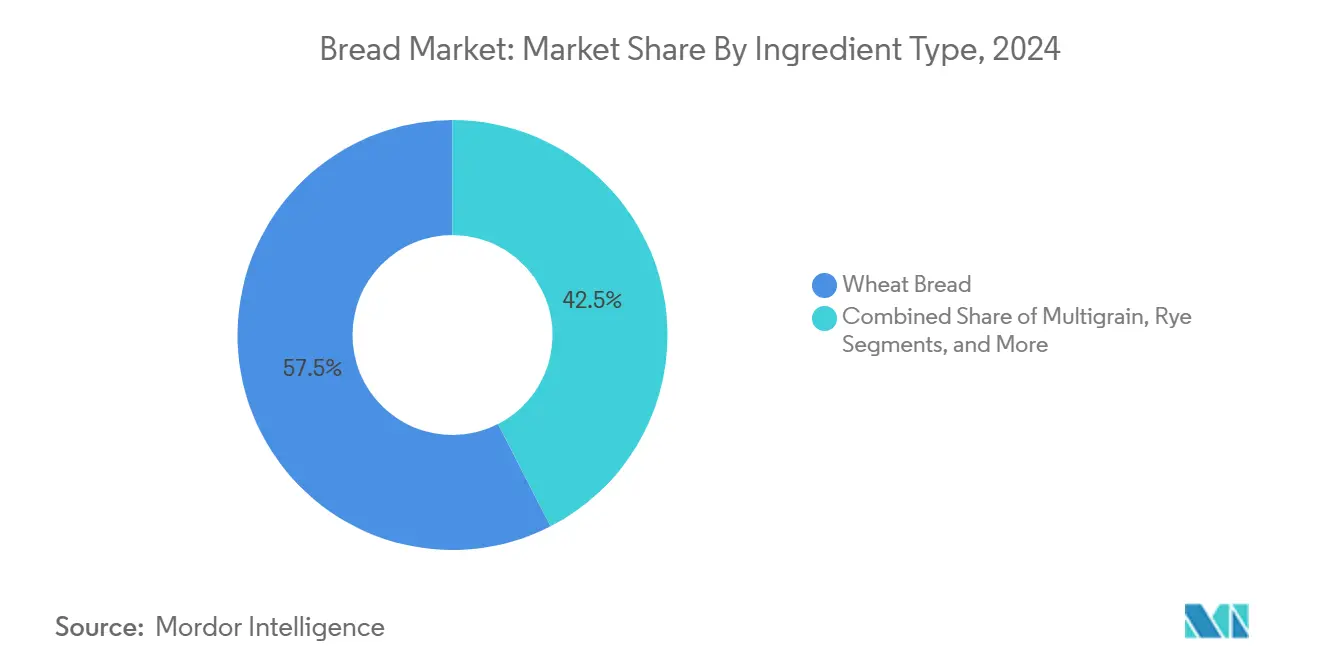
Note: Segment shares of all individual segments available upon report purchase
By Product Type: Leavened Bread Dominates, Unleavened/Flat Bread Accelerates
In 2024, leavened bread holds 57.65% of the market share, maintaining its leading position due to its versatility and strong consumer preferences. Loaves are a key part of daily consumption, especially in sandwiches, which are popular across regions. However, their growth is slower compared to the unleavened/flat bread segment, which is growing at a 4.42% CAGR from 2025 to 2030, twice the overall market rate. Companies like Lancaster Colony are driving innovation with gluten-free frozen bread that closely matches traditional bread in texture and taste. Burger buns and sandwich slices show steady growth, while ciabatta and baguettes are seeing moderate growth in foodservice within the bread market.
The unleavened/flat bread segment is growing quickly due to demand for convenience, less food waste, and high-quality products available on demand. Advances in freezing technology, such as OctoFrost's Multi-Level Impingement Freezer, have improved product quality by addressing issues like dehydration and deformation. Rolls and specialty items like brioche are gaining market share, with brioche standing out for its versatility and premium appeal. Grupo Bimbo's acquisition of St Pierre Groupe highlights the importance of this subsegment. Other product types are losing market share as consumers focus on mainstream options with clear benefits.
By Nature: Organic growth outpaces conventional
In 2024, conventional bread held an 85.21% market share, supported by established production infrastructures, accessible pricing, and extensive distribution networks. Economies of scale enable competitive pricing and steady retail availability. However, while conventional bread's growth remains slow, organic alternatives are growing at a 9.27% CAGR (2025-2030), nearly tripling the market's overall pace. This reflects a shift in consumer priorities toward transparency, sustainability, and wholesome ingredients. Major players like Bimbo Bakeries USA are responding by introducing organic variants of their Arnold and Brownberry brands.
The organic bread segment's growth is driven by sustainability efforts across the value chain. Companies such as Pågen are sourcing organic ingredients locally to reduce carbon emissions and repurposing unsold bread into bioethanol or animal feed. The USDA's USD 300 million Organic Transition Initiative supports producers transitioning to organic methods, potentially increasing ingredient availability [3]U.S Department of Agriculture, "Organic Transition Initiative in Action", www.usda.gov. While premium pricing offers margin advantages to offset rising input costs and competition, challenges like price sensitivity and supply chain complexities persist. If current trends continue, organic bread could capture 20-25% of the market by 2030, reducing conventional bread's dominance in the bread industry.
By Distribution Channel: Off-Trade Dominate, On-Trade Gains Momentum
In 2024, the off-trade channel commands a dominant 65.34% share of the global bread market's distribution landscape, driven by factors such as convenience, wider product availability, and competitive pricing. These channels include supermarkets, hypermarkets, convenience stores, and online platforms, which cater to a broad consumer base by offering a variety of bread products, including packaged, frozen, and specialty options. The increasing penetration of e-commerce platforms has further strengthened the off-trade segment, as consumers increasingly prefer the ease of online shopping and home delivery services.
At the same time, the on-trade segment, encompassing restaurants, cafes, hotels, and other foodservice outlets, is on an upward trajectory. This segment is projected to achieve a robust CAGR of 7.33% from 2025 to 2030, fueled by increasing consumer preference for dining out, the rising popularity of artisanal and specialty bread offerings, and the growing trend of pairing bread with gourmet meals. Additionally, the expansion of quick-service restaurants (QSRs) and bakery cafes globally is contributing to the growth of the on-trade segment. The shift in consumer behavior toward premium and freshly baked bread products in foodservice establishments is further driving this segment's growth during the forecast period in the bread industry.
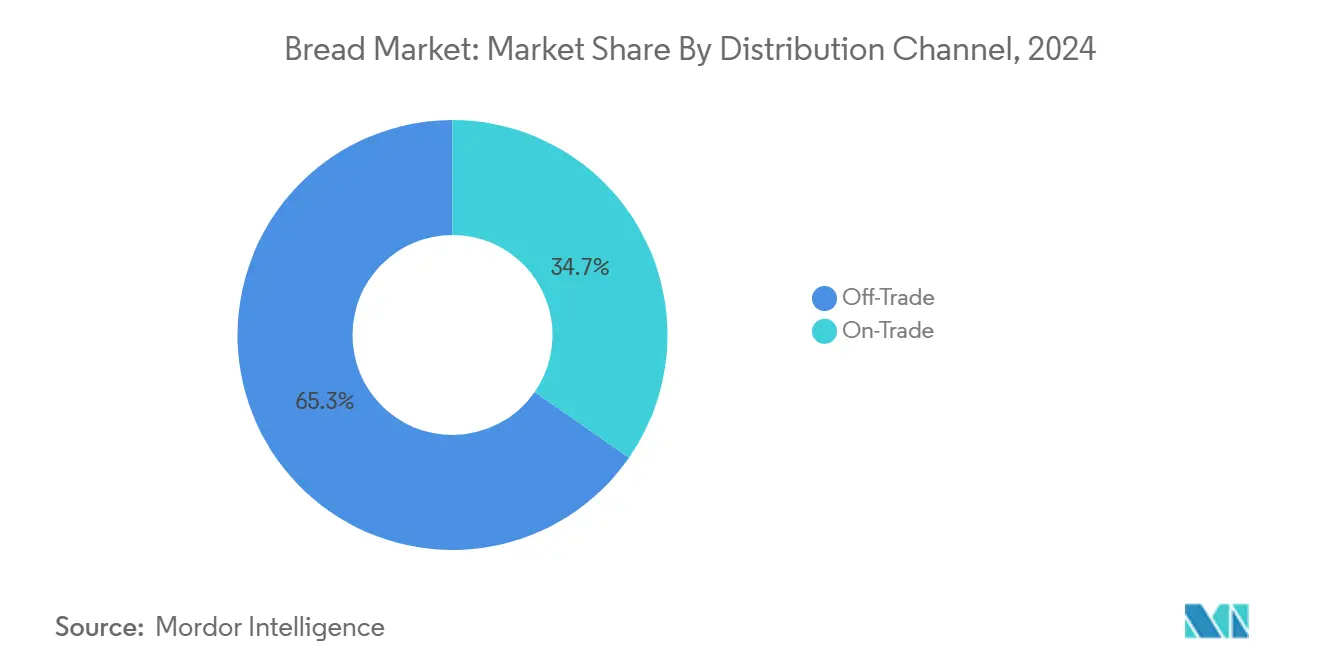
Note: Segment shares of all individual segments available upon report purchase
Geography Analysis
Europe claimed a 29.82% share of the global bread market in 2024. With its rich bread traditions and an evolved retail landscape, Europe is a key player on the world stage. The UK, Germany, and France dominate the continent, showcasing unique consumption patterns. A report from the Federation of Bakers highlights that while bread consumption holds steady in Western Europe, there's a pronounced disparity between nations. Notably, Germans and Austrians top the list, each indulging in roughly 80 kg of bread per person each year [4]Federation of Bakers, "Ëuropean Bread Market", www.fob.uk.com. By 2025, trends indicate a shift towards local authenticity in bakeries, with consumers increasingly valuing regional grains and time-honored recipes.
Asia is poised as the region with the most rapid growth, projecting a 4.83% CAGR from 2025 to 2030. This surge is attributed to urbanization, a tilt towards Western diets, and rising disposable incomes. Within Asia, China, India, and Japan take the lead, each charting distinct growth paths. The packaged bread sector is booming, spurred by urban dwellers favoring convenience over traditional fresh options. E-commerce is a game-changer in this evolution, expanding the reach of bread products both geographically and demographically. However, economic headwinds persist, with HSBC flagging a "crisis of value" in China and Southeast Asia, reshaping food purchasing habits.
North America, with its health-centric product innovations and robust retail framework, commands a significant market share. The region's bread market is seeing increased demand for gluten-free, organic, and low-carb options, reflecting a shift towards healthier lifestyles. Retailers and manufacturers are focusing on clean-label products to meet consumer preferences for ingredient transparency. While Canada and Mexico are smaller players, they are aligning with U.S. trends and showing growth. Canada is experiencing rising demand for artisanal and specialty breads, while Mexico is seeing growth in fortified bread products targeting nutritional deficiencies. These trends highlight the region's adaptability and potential for sustained growth.
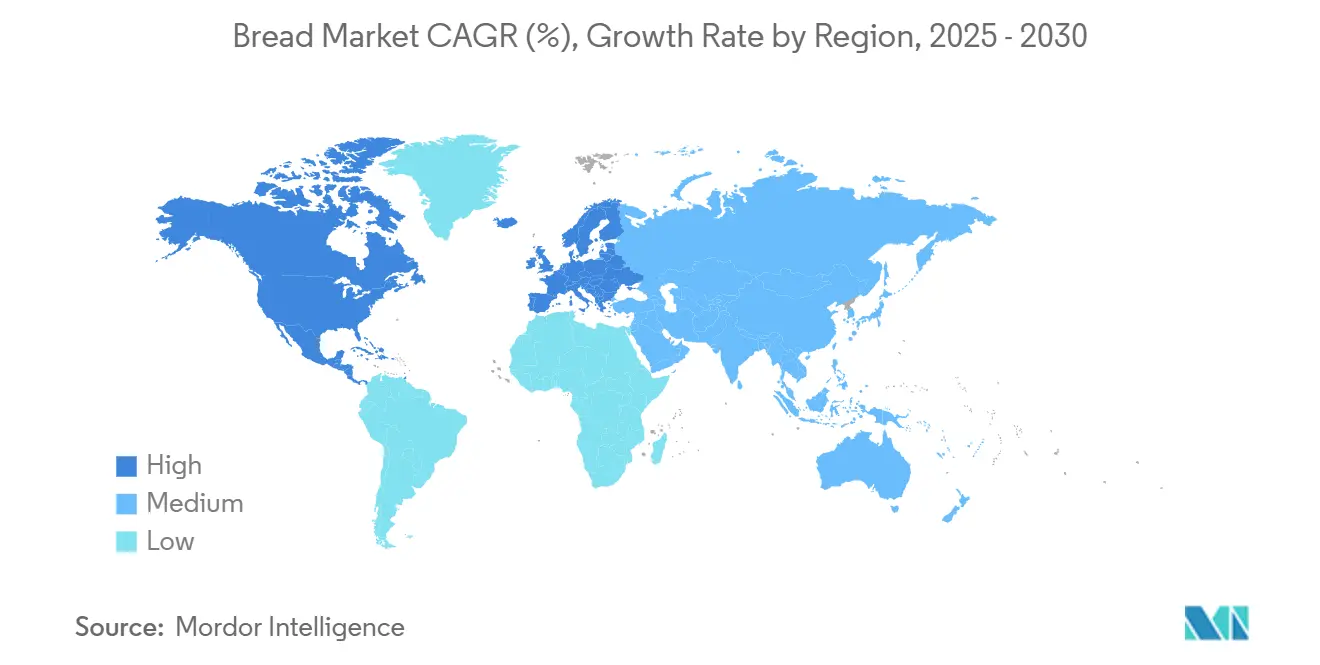
Competitive Landscape
The global bread market is moderately fragmented, with multinational corporations, regional leaders, and local specialists actively competing across different price ranges and product categories. Grupo Bimbo SAB de CV, Flowers Foods, Inc., and Associated British Foods plc lead the market by leveraging their extensive distribution networks and diverse brand portfolios. However, smaller specialists focusing on premium products are increasingly challenging their dominance by offering unique and high-quality options that appeal to niche consumer preferences across the bread industry.
Technology plays a crucial role in shaping competition within the market. Leading companies are actively adopting automation to streamline production processes, reduce costs, and address labor shortages. They are also investing in digital tools to enhance operational efficiency and improve customer engagement. Advanced packaging solutions are being implemented to extend product shelf life and maintain freshness, which is critical for consumer satisfaction. Additionally, artificial intelligence is transforming the industry by optimizing manufacturing processes, predicting consumer trends, and enabling the creation of innovative products tailored to evolving demands.
Competition varies significantly across regions and product segments. Premium and health-focused categories are witnessing intense innovation as companies strive to meet the growing demand for healthier and more specialized bread options. On the other hand, mainstream segments face challenges from the rising popularity of private label products, which offer cost-effective alternatives, and the volatility of input costs, which puts pressure on profit margins. Companies must continuously innovate and adapt to these dynamics to maintain their competitive edge in the market.
Bread Industry Leaders
-
Grupo Bimbo S.A.B. de C.V.
-
Associated British Foods plc
-
Yamazaki Baking Co., Ltd.
-
Flowers Foods, Inc.
-
Campbell Soup Company
- *Disclaimer: Major Players sorted in no particular order
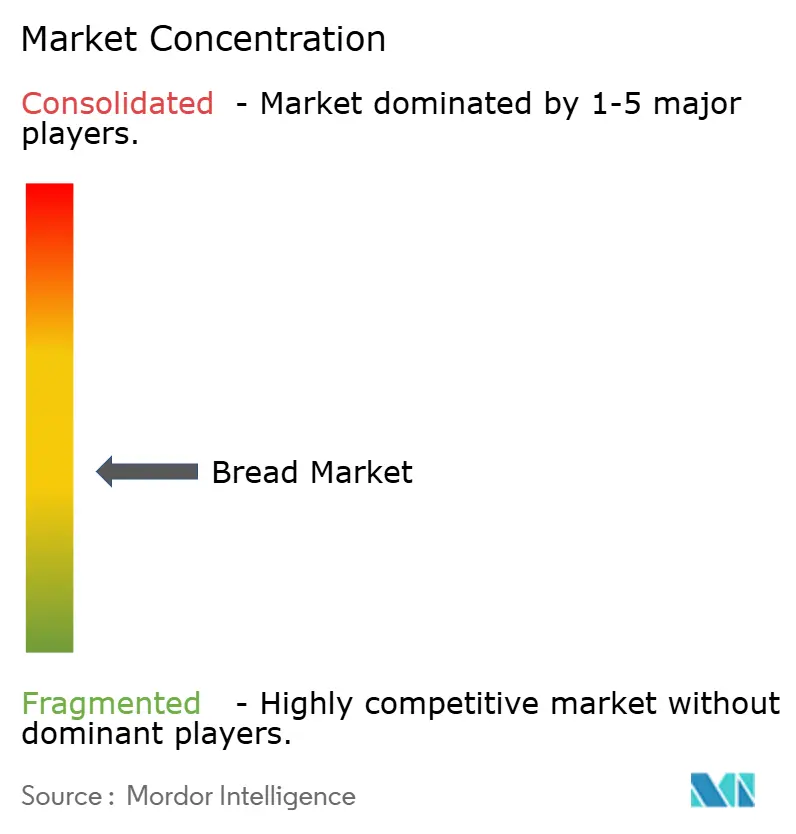
Recent Industry Developments
- January 2025: Flowers Foods acquired Simple Mills for USD 795 million, significantly expanding its presence in the better-for-you baked goods segment with a brand known for clean ingredients and nutritional focus.
- January 2025: Schmidt Baking, part of the H&S Family of Bakeries, has rolled out a new bread line under its Old Thyme brand, named Artisan’s Choice. The lineup features three distinct varieties: Italian Rustico, crafted with olive oil, sea salt, garlic, and onion; and Rustic Brioche, a sweet, indulgent loaf that's both dairy and egg-free.
- December 2024: Furlani Foods announced the acquisition of Cole's Quality Foods, a notable player in the frozen garlic bread market with two production facilities in Michigan, strengthening Furlani's position in the frozen bread segment.
- September 2024: Grupo Bimbo expanded its South American presence by acquiring Brazil-based Wickbold brands, enhancing its product portfolio and distribution capabilities in the region's largest bread market.
Research Methodology Framework and Report Scope
Market Definitions and Key Coverage
Our study defines the global bread market as all leavened and unleavened loaves, rolls, buns, baguettes, and flatbreads baked from grain-based dough and sold fresh or frozen through retail, foodservice, and institutional channels across every major geography. Bread from both artisanal bakeries and industrial lines is counted at wholesale value in USD.
Products such as bread mixes, improvers, crumbs, pizza-crust blanks, and non-grain substitutes are outside this scope.
Segmentation Overview
- By Product Type
- Leavened Bread
- Loaves
- Baguettes
- Burger Buns
- Sandwich Slices
- Ciabatta
- Other Product Types
- Unleavened / Flat Bread
- Tortilla
- Pita
- Chapati/Roti/Paratha
- Others
- Leavened Bread
- By Ingredient Type
- Wheat Bread
- Rye Bread
- Multigrain Bread
- Other Ingredients
- By Nature
- Conventional Bread
- Free-From Bread
- By Distribution Channel
- Off-Trade
- Convenience/Grocery Stores
- Specialist Retailers
- Supermarkets/Hypermarkets
- Online Retail
- Other Channels
- On-Trade
- Off-Trade
- By Geography
- North America
- United States
- Canada
- Mexico
- Rest of North America
- Europe
- Germany
- United Kingdom
- Italy
- France
- Spain
- Netherlands
- Poland
- Belgium
- Sweden
- Rest of Europe
- Asia-Pacific
- China
- India
- Japan
- Australia
- Indonesia
- South Korea
- Thailand
- Singapore
- Rest of Asia-Pacific
- South America
- Brazil
- Argentina
- Colombia
- Chile
- Peru
- Rest of South America
- Middle East and Africa
- South Africa
- Saudi Arabia
- United Arab Emirates
- Nigeria
- Egypt
- Morocco
- Turkey
- Rest of Middle East and Africa
- North America
Detailed Research Methodology and Data Validation
Primary Research
Mordor analysts interviewed commercial bakers, grain millers, ingredient blenders, and grocery buyers across North America, Europe, Asia-Pacific, South America, and the Middle East and Africa. These conversations confirmed average selling prices, premiumization trends, gluten-free penetration, and plant-capacity utilizations that secondary data only hinted at.
Desk Research
We began with factual datasets from sources such as FAO crop balances, USDA ERS grain outlooks, Eurostat retail indices, and the Federation of Bakers consumption panels to frame supply, demand, and price corridors. Company filings and investor decks strengthened channel-split assumptions, while news archives from Dow Jones Factiva and financials within D&B Hoovers informed competitive concentration.
Trade-association releases, UN Comtrade shipment ledgers, and peer-reviewed nutrition journals provided signals on health-driven product shifts. The list above is illustrative, and many other publications were consulted for data collection, validation, and clarification.
Market-Sizing and Forecasting
We apply a top-down reconstruction that starts with country-level flour usage and bread-production statistics, then adjusts for trade flows and wastage to derive apparent bread output. Results are cross-checked with selective bottom-up roll-ups of sampled baker revenues and retailer scan volumes. Key variables include global wheat output, per-capita bread intake, packaged-bread share in urban retail, average loaf ASP progression, and health-claim penetration. A multivariate regression model projects each driver through 2030, and scenario stress tests refine growth in volatile grain-price years before final sign-off by our lead analyst team.
Data Validation and Update Cycle
Outputs pass three-layer variance checks, peer review, and senior sign-off. Reports refresh annually, with interim updates triggered when a material shock, such as a harvest shortfall or new labeling law, alters the base equation. A final pass is run just before delivery so clients receive the latest view.
Why Mordor's Bread Baseline Commands Reliability
Published estimates often diverge because firms choose dissimilar product lists, pricing nodes, and refresh cadences. Key gap drivers include packaged-only scopes, aggressive ASP escalators, or reliance on historical consumption elasticities that new operator feedback no longer supports.
Benchmark comparison
| Market Size | Anonymized source | Primary gap driver |
|---|---|---|
| USD 245.13 B (2025) | Mordor Intelligence | |
| USD 342.4 B (2024) | Global Consultancy A | Excludes unpackaged artisanal bread yet inflates value by applying retail markups across all units |
| USD 196.95 B (2024) | Trade Journal B | Limited country coverage and flat ASPs that ignore premium health segments |
This comparison shows that Mordor's disciplined scope selection, variable tracking, and annual refresh deliver a balanced, transparent baseline that decision-makers can trust.
Key Questions Answered in the Report
What is the Bread market size in 2025 and how fast will it grow?
The Bread market size equals USD 245.13 billion in 2025 and is forecast to rise to USD 296.04 billion by 2030 at a 3.85% CAGR.
Why is organic bread gaining momentum?
Organic SKUs carry margins up to 30% above conventional loaves, and government programmes such as the USDA Organic. Transition Initiative broaden certified grain supply, driving a 9.27% CAGR.
Which region records the highest growth rate?
Asia-Pacific leads regional expansion with a 4.83% CAGR, supported by urbanisation and growing packaged-bread penetration.
How are bakers handling wheat-price volatility?
Large firms hedge grain contracts, while smaller bakeries resize loaves and adjust recipes; both groups invest in logistics efficiency to cushion margin pressure.
Page last updated on:
